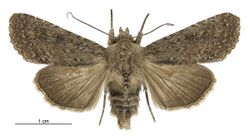Biology:Physetica homoscia
| Physetica homoscia | |
|---|---|

| |
| Female | |

| |
| Male | |
| Scientific classification | |
| Domain: | Eukaryota |
| Kingdom: | Animalia |
| Phylum: | Arthropoda |
| Class: | Insecta |
| Order: | Lepidoptera |
| Superfamily: | Noctuoidea |
| Family: | Noctuidae |
| Genus: | Physetica |
| Species: | P. homoscia
|
| Binomial name | |
| Physetica homoscia (Meyrick, 1887)[1]
| |
| Synonyms[2][1] | |
| |
Physetica homoscia is a species of moth of the family Noctuidae. It is endemic to New Zealand and is found throughout New Zealand including in the Auckland Islands. This species inhabits places where its host plants are common and this includes costal dune habitat. It lives at a wide range of altitudes from sea-level up to at least 1750 m. The larvae of P. homoscia feed on Ozothamnus leptophyllus and Ozothamnus vauvilliersii. They are very active and drop to the ground when disturbed. Larvae are parasitised by a species of fly. This species pupates in the soil and the pupa life stage lasts for approximately 6 weeks. The adult moths are on the wing from September to June and are attracted to light. The adults of P. homoscia might possibly be confused with Ichneutica moderata however this latter species lacks the small white dots on the forewing veins of P. homoscia. Adults might also be confused with P. temperata but P. homoscia is significantly larger in size.
Taxonomy
This species was first described by Edward Meyrick in 1887 and named Mamestra homoscia.[3] In 1898 George Hudson placed this species within the genus Melanchra.[4] George Hampson thinking he was describing a new species, named this moth Hyssia sminthistis in 1905.[5] Meyrick synonymised this latter name into Melanchra homoscia.[6] In 1971 J. S. Dugdale placed this species in the genus Graphania.[7] In 1988 Dugdale confirmed this placement in his Catalogue of New Zealand Lepidoptera.[2] In 2017 Robert Hoare undertook a review of New Zealand Noctuinae and placed this species in the genus Physetica.[1] The male holotype specimen was collected by George Hudson in Wellington and is held at the Natural History Museum, London.[1]
Description
Dugdale described the larva of this species as follows:
Body colour pattern in black and yellowish or greenish brown, variegated. Dorsal area longitudinally, darkly marbled, seta D1 on a small, and D2 on a large white patch, the D2 patch connected with a prominent pallid subdorsal line; zone between this and spiracle longitudinally marbled; spiracle on a dark patch, subspiracular line broadest behind, narrowest just in front of spiracle; subventral and ventral zones pallid, obscurely marbled; ventral line obscure to prominent.[7]
Meyrick originally described the species as follows:
Male. — 38 mm. Head, palpi, antennae, thorax, abdomen, and legs grey ; antennae with short triangular transverse dentations (1⁄2), strongly ciliated ; thorax with moderate anterior crest ; anal tuft ochreous-tinged. Forewings moderately dilated, costa almost straight, apex obtuse, hindmargin crenulate, obliquely with two tolerably distinct series of white dots, preceded and followed by black marks, before first and beyond second lines ; lines dark-margined, tolerably defined ; orbicular and claviform hardly traceable ; reniform indicated by whitish lateral margins ; subterminal faintly paler, not dark-margined, waved : cilia grey. Hindwings grey, darker posteriorly ; cilia grey-whitish, with a cloudy grey line.[3]
The wingspan of the adult male is between 29.5 and 43 mm and the adult female is between 35 and 46 mm.[1] P. homoscia has a plain brown coloured forewing and older specimens can possibly be confused with Ichneutica moderata.[1] However this latter species lacks the small white dots on the forewing veins that are present on the forewings of P. homoscia.[1] It might also be confused with P. temperata however P. homoscia is significantly larger in size.[1]
Distribution
This species is endemic to New Zealand.[8][9] It is found throughout New Zealand including in the Auckland Islands.[1]
Habitat
This species inhabits places where its host plants are common and this includes costal dune habitat.[1] It lives at a wide range of altitudes from sea-level up to at least 1750 m.[1]
Behaviour
The larvae are very active and drop to the ground when disturbed.[4] The adult moths are on the wing from September to June and are attracted to light.[1][4]
Life history and host species
Larvae of P. homoscia feed on Ozothamnus leptophyllus and Ozothamnus vauvilliersii.[1] Hudson states that the larvae are parasitised by a species of fly.[4] The larvae pupate in the soil and the pupa life stage lasts for approximately 6 weeks.[4]
References
- ↑ 1.00 1.01 1.02 1.03 1.04 1.05 1.06 1.07 1.08 1.09 1.10 1.11 1.12 , pp. 43-44, Wikidata Q44893580
- ↑ 2.0 2.1 , pp. 202v, Wikidata Q45083134
- ↑ 3.0 3.1 , pp. 21-22, Wikidata Q104048034
- ↑ 4.0 4.1 4.2 4.3 4.4 , pp. 21, Wikidata Q19073637
- ↑ , pp. 280, Wikidata Q97092303
- ↑ , pp. 102, Wikidata Q107609940
- ↑ 7.0 7.1 , pp. 121, Wikidata Q64006453
- ↑ "Physetica homoscia (Meyrick, 1887)". 2021. https://www.nzor.org.nz/names/2ff1b4b3-35a0-4be8-89a2-9be5b4d731b9.
- ↑ "Physetica homoscia (Meyrick, 1887)". 2021. https://nztcs.org.nz/nztcs-species/47402.
Wikidata ☰ Q51068024 entry
 |




